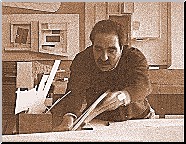![]()

"What is being discussed today is the actual survival of architecture"
Souto de Moura's work has attracted attention both in and out of Portugal. This has come about not only because of his reduction of formal means reminiscent of Mies van der Rohe but also because of his sensitive treatment of situational factors. But as Antonio Angelillo's analytical essay makes clear, Souto de Moura is as little interested in dusting off models of the early modern movement as in a simplistic adaptation to the context in which he has to build. Both his linguistic reduction and his contact with the context appear - surprisingly enough - to have their roots in contemporary American sculpture. Artists like Robert Morris, Donald Judd and Sol Le Witt transformed the environment by placing assertive new objects into it. And that is exactly what Souto de Moura does.
Souto de Moura is not a 'contextualist'. His buildings are never complacent answers to the topographic and morphological qualities that he encounters at a particular site. His interventions always generate a new, formal field of force that rearranges the situation and imposes a new order upon it. Like the above sculptors, what he is concerned with is making discrete, precise but very convincing gestures in a field of relations, but without neglecting the 'weak' signs also encountered in the environment. Within such a field of relations, ruins, interstitial urban zones and decayed spaces of the periphery can be charged with new, even dominant meanings. Angelillo correctly makes a connection here with the novels of Peter Handke and the films of Wim Wenders. Souto de Moura's architecture sets out to offer resistance. Walls of chiselled granite blocks, steel-framed fašades of reflecting glass and floors of Brazilian tropical wood give his work an aura of serene monumentality and generous luxury. Yet these materials are relatively inexpensive in Portugal and the Miesian formal reduction and the emancipation of floors, walls and columns, both of which characterise his work, are mainly inspired by a design strategy and construction procedure that take into account the depressingly low level of Portuguese building skills; in Portugal, conformity between a drawing and a realised building is more a fluke than the result of purposive action.
The formal language and the materials that the Portuguese architect avails himself of lend his buildings a material and sensual permanence, in which everyday life with its variety and transcience can esconce itself at will. This contrast between sensual and material eloquence and the relative indifference to the programme - which is not, after all, controllable by the architect - makes Souto de Moura's work particularly topical. In this respect, the drawings and photographs have the final word. But besides looking at the illustrations, architects may derive pleasure from reading the interview with Souto de Moura, in which he shows a down-to-earthness that will appeal to many. He says, for example, 'the site is whatever you want it to be'. The solution never comes from the site but always from people's heads. The site is simply there. For the architect it's an instrument, a tool, just like a pencil. The same applies to typology. Souto de Moura denies that the modern movement has radically altered the typology of housing and emphasizes the similarities between Roman patio houses and the 'court houses' of Mies van der Rohe. Housing typology is inextricably bound up with life style and we shouldn't fool ourselves into thinking that so much has altered over the centuries. Souto de Moura's work is certainly changing, however. He is designing a 'new inventory' of materials, strategies and forms, and thereby showing considerable affinity with the work of Swiss architects Herzog and De Meuron. At the same time his fascination for Donald Judd is becoming more and more apparent. The design strategy and construction procedure which he has had to sustain for years to maintain his position in the Portuguese building world is now necessarily being subjected to revision. This is partly a result of his success.
Owing to Portugal's integration within the European Union, owing to the commissions Souto de Moura has obtained abroad, and because he receives not only minor commissions such as private houses but also has to address offices, banks and hotels, the field of influence he considers necessary for architecture's survival has changed. For, as Souto de Moura says in the book devoted to him, 'what is being discussed today is the actual survival of architecture itself'.
Hans Van Dijk (first published in the December 1994 issue of Archis)
Eduardo Elisio Machado Souto de Moura was born on July 25th 1952 in Oporto, Portugal. He studied architecture at the School of Fine Arts in Oporto, receiving his degree in 1980. From 1974 to 1979 he worked with Alvaro Siza at his architectural practice.
From 1981 to 1990, Souto Moura was assistant professor at his alma mater, and was later appointed Professor at the University of Oporto Faculty of Architecture.
He has been visiting professor at the architectural schools of Geneva, Paris-Belleville, Harvard, Dublin, ETH Zurich and Lausanne, and has participated in numerous seminars and given many lectures both in Portugal and abroad. His work has appeared in various publications and exhibitions.
He has been awarded the following prizes: the Antonio de Almeida Foundation prize; the Antero de Quental Foundation prize; 1st prize in the Competition for the Restoration of Giraldo Square in Evora, Portugal; 1st prize in the Competition for the CIAC Pavilions; ist prize in the Competition for a Hotel in Salzburg, Austria; 1st prize in the "IN/ARCH 1990 for Sicily" Competition; the Secil Prize for Architecture; 2nd prize in the "Architecture and Stone" ideas competition; honourable mention for his Miramar House in the Secil Architectural Prizes; honourable mention for both the SEC Cultural Centre and the Alcanena House in the National Architectural Prizes.
Editorial Blau, Lda.
Av. Marques de Tomar, 68 - 4A
Lisbon, Portugal
Tel: +351-1-797-9912 Fax: +351-1-793-8341
E-mail: Blau webmaster